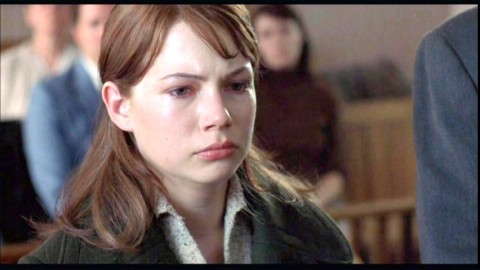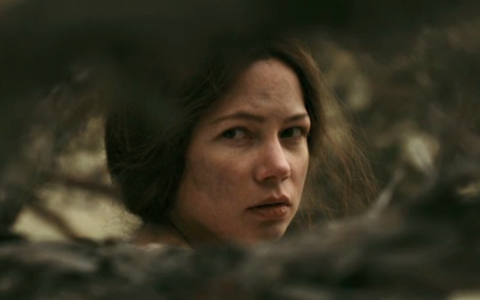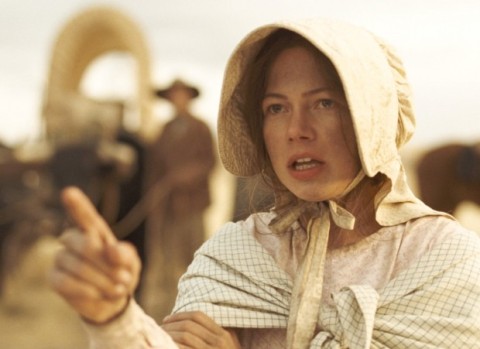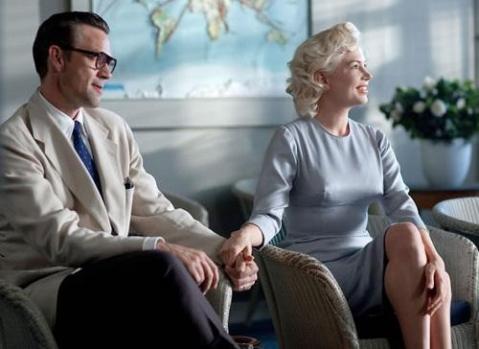Feminéma’s La Jefita Awards, Part II
18 February 2013
There’s nothing like the La Jefitas, is there? No, really, there’s nothing like it. This list of the best 2012 films by and about women — designed to celebrate those female bosses of modern film and subvert a male-dominated and sexist film industry — is exactly what we need during years like this one, when not a single female director was nominated at the Cannes Film Festival or at the Oscars. I mean come on.
Plus, the La Jefitas feature much better statuettes.
Just to bring you up to date from yesterday’s winners:
- Best Actress: Anna Paquin in Margaret
- Female-Oriented Scene I Never Expected to See Onscreen: the abortion scene in Prometheus
- Best Fight Scene in Which a Woman Kicks a Man’s Ass: Gina Carano taking down Michael Fassbender in Haywire
- Most Depressingly Anti-Feminist Trend of the Year: Where did all the roles for Black women go?
- Most Feminist Trend in Film in 2012: 2012 was the Year of Fierce Girls Onscreen
- Best Breakthrough Performance by an Actress Known for Very Different Roles: Jennifer Lawrence in Silver Linings Playbook
- Most Feminist Film: Nadine Labaki’s Where Do We Go Now?
Be sure to check out the full post to find out more about honorable mentions, reasons for establishing these categories, and gorgeous images from the films.
Before we finish the awards ceremony, I feel it incumbent on me to discuss the sad fate of my favorite category: Sexiest Scene in Which a Woman Eats Food. This year’s films did not have a single contender for this prize — a sad state of affairs and a sure measure of the state of our world. To be sure, I had a couple of films in which a woman ate food in an incredibly unsexy way (winner: Shirley MacLaine in Bernie) but that’s not the kind of prize I want to offer at all. Filmmakers: fix this, please.
And now on to the exciting 2012 winners!
Best Female-Directed Film:
This was absolutely the hardest category to determine — I even toyed with breaking my films-only rule and awarding it to Lena Dunham for her series Girls. But in the end there was one film I couldn’t get out of my head: Lauren Greenfield’s documentary The Queen of Versailles, which (inexplicably) I never got the chance to write about last year. (Also was inexplicably ignored by the Academy Awards. Do you see why the La Jefitas are so vital?)
Now this is brilliant filmmaking with a healthy dose of sheer karma. When Greenfield began, she simply wanted to create a documentary about a couple in the process of building the largest house in America, which they had already named Versailles. “In a way, it just seemed like this incredible microcosm of society that showed our values. Both Jackie and David [Siegel] had rags-to-riches stories,” she told Vanity Fair.
But after the financial crisis hit and month after month passed by with increasing stress for the family, the director realized she had to change the story of the documentary. If it started out as a story about self-made Americans and their desire to symbolize their success in a house, by the time “they had to put [the half-finished house] on the market, I realized that this was not a story about one family or even rich people,” Greenfield continues. “It was an allegory about the overreaching of America and really symbolic for what so many of us went through at different levels.”
If you haven’t seen The Queen of Versailles, run — don’t walk — to your television and load it up right away. It’ll make you laugh and cringe, but most of all it’s a fascinating cinema insight into our culture’s obsession with wealth and display. Also, just for those scenes of the chaos in the Siegel household after they are forced to let go of so many maids.
Best Uncelebrated Supporting-Supporting Actor:
Jeannie Berlin in Kenneth Lonergan’s Margaret. As the best friend of a woman killed in a bus accident, Berlin attracts the attention of the young Lisa (Anna Paquin) for all the wrong reasons. But you can see why she would appeal so deeply. Prickly and no-nonsense, independent but capable of deep love for her friends, and — most important for Lisa — lacking a need for male attention, she seems perhaps to be the perfect replacement for Lisa’s actual mother. Best of all, she wears her Jewishness on her sleeve rather than push it to the side. Her self-possession is most of all marked by the way Berlin chooses to enunciate her words slowly and methodically, which has a surprising power over the emotional mess of a fast-talking teenager, like a balm to her soul. No wonder Lisa feels so suddenly invested in connecting to this woman.
But she also sees Lisa’s selfishness clearly, and refuses to play a role in Lisa’s mini-drama of denial. It’s a beautiful performance that seems all the more meaningful because the film was so utterly shut out of Oscar competition this year, in part due to its complicated production. Here’s hoping a La Jefita ensures that Berlin gets a lot more work and recognition from here on out (is there a La Jefita bump? let’s find out!).
Best Role for a Veteran Actor Who Is Not Meryl Streep or Helen Mirren:
Emmanuelle Riva as Anne in Michael Haneke’s Amour. I only wish I’d seen this film with friends so I could debrief about it and Riva’s performance at length. It’s hard to believe that this magnificent, beautiful performer has only made 14 films since her début in 1959’s Hiroshima, Mon Amour. I tried many times to write about it here but found myself inadequate to the task; suffice it to say that even with a grim story like this one, the amour triumphs in a way that the inevitability of mortality does not.
Amour is such a perfect portrayal of a good marriage in its final stage that it’s difficult for me to speak of Riva’s performance separate from that of Jean-Louis Trintignant as Anne’s husband Georges. Indeed, I don’t know how the Academy overlooked Trintignant for a Best Actor nomination; the scenes between them are so tender and honest that we’re left with powerfully mixed feelings. On the one hand, it made me desire with all my heart that I will have such a companion when I’m in my 80s (and oh, I’m almost terrified to hope it is my perfect, wonderful partner of today); on the other hand, I hope we will get mercifully hit by a train together on the same day. When it came to playing the role of a woman wrestling with rapidly-advancing debilities of age, Riva gave the role such realistic tenderness and brutality that I swear it must have taken part of her soul. As I watched so many of those scenes, I marveled — how did the 85-yr-old Riva make it through the filming, considering that she must have these same fears of aging on her mind?
Riva’s achievement is all the more impressive because of the stiff competition by veteran actresses this year. Just think of Sally Field in Lincoln and you’ll know whereof I speak; I also include Shirley MacLaine’s comic turn in Bernie and Nadezhda Markina in Elena. Truly: it was a great year for veteran actors.
Best Breakthrough Performance By an Unknown Actor:
No questions here: Quvenzhané Wallis in Beasts of the Southern Wild. I know this film didn’t work for everyone; indeed, the naysayers include big names in cultural criticism. But I believe this film constitutes a visionary outsider’s statement from a child’s point of view — a lovely statement about belonging and existence that ties together deep poverty and wild imagination.
Wallis is so good that it makes me fret about her future — is she really a major acting talent, or a disarmingly wonderful child whose acting will vacillate as she grows older? Nor am I the only one to ask those questions. It makes me nervous about her Best Actress nomination from the Academy.
But in the end all this second-guessing is unfair to the performance as it appeared in this film, a performance that was just perfect. No child, much less any other 6-yr-old, could have gotten it so right this one time. And with that, I’m looking forward to the next role as eagerly as any of her other fans.
Performance So Good It Saves a Terrible Film … well, no, but almost:
Eva Green in Tim Burton’s Dark Shadows. I don’t have anything good to say about this film except that every time the evil witch Green showed up, I started having a good time again.
That blonde wig! The facial twitches! The sex scene in Green’s office! Her gift for physical comedy!
What can we say about the film overall, except that it was confused and that it had a very few funny lines (all of which are helpfully compiled in the film’s trailer)? Yet Green was fantastic. Give this woman more work.
Most Delightful Way to Eschew Narrative in Favor of Pleasure in Female-Centered Films:
They stop what they’re doing and start dancing. I can’t even remember how many times various films this year just stopped what they were doing and featured a great dance number — and I’m not even speaking here about explicit dance films like Pina, Magic Mike, or Step Up 4: Revolution. Remember the weird finale to Damsels in Distress, in which Greta Gerwig and Adam Brody sing the deliciously goofy “Things are Looking Up” and dance awkwardly through a pastoral scene? Or the final act of Silver Linings Playbook, all of it hinging on the goofy routine worked up by two (ahem) non-professionals? In Take This Waltz?
Or the scene at the homecoming dance when the three leads let their freak flags fly in The Perks of Being a Wallflower?
Once you start to put them together, you find a lot of mini-moments onscreen when films adhered to the old theater maxim, you sing when you can no longer speak, you dance when you can no longer walk. Dancing has the capacity to take us out of the fictional magic of the narrative one step further and launch us into true fantasy. Is it a narrative shortcut? oh, who cares. I love it.
Film of the Year:
Kathryn Bigelow’s Zero Dark Thirty. Really: there’s just no question. This would receive my Film of the Year prize even if it had been directed by a man and/or featured a male protagonist.
Nor was it easy for me to let go of Kenneth Lonergan’s Margaret; I even toyed with the possibility of declaring a tie. But I believe Zero Dark Thirty achieves something even beyond the former in working its viewers through the emotional aftershocks of that methodical search for our proclaimed enemy — it wants us as a culture to move away from retribution and toward some kind of catharsis.
My appreciation for the film certainly doesn’t rest on Jessica Chastain’s performance, which didn’t work for me all the time. Rather, it’s the architecture of the overall film and the accelerating action-film aspects that lead toward an exhilarating (but ultimately distracting). Whereas poor Margaret shows in its fabric the scars of so many cooks in the kitchen, Zero Dark Thirty is just a masterful piece of work that amounts to more than the sum of its parts, and Kathryn Bigelow was robbed when the Academy failed to nominate her for a Best Director Oscar.
So there you have it, friends — the year’s La Jefitas! Please don’t hesitate to argue, debate, send compliments (oh, how I love compliments), and offer up new ideas for categories. (You gotta admit, my Most Delightful Way to Eschew Narrative in Favor of Pleasure in Female-Centered Films category should receive a Pulitzer on its own!)
Michelle Williams’ mouth
2 July 2012
Michelle Williams’ mouth is the thing I stare at when I watch her. As an actress she can be a chameleon — I mean, Marilyn Monroe! — but in the end her mouth alone does so much to convey complicated emotions. Her mouth is what always makes her performance so distinctive.
Her mouth has gravity. Her mouth shows her disappointment, her struggles. Michelle Williams has the mouth that belies all her other beautiful attributes. Even when she enacts (very effectively) the lusciousness of Monroe, her mouth brings us back:
Whereas the real Monroe’s mouth only confirmed our mythos about her (tongue is in evidence):
Readers will know that I’ve always got my eyes open for actresses who break out of the ridiculously strict Hollywood standards when it comes to noses, mouths, body size, and other body parts so frequently adjusted by plastic surgeons. Now, don’t get me wrong: I’m certainly not saying that Michelle Williams’ mouth is unattractive or shaped oddly — far from it. Williams is a beautiful woman in many, many conventional ways.
And yet. Her full cheeks and mouth do things that render Williams’ conventional beauty so much more interesting. Her mouth almost makes me think that she doesn’t truly know how beautiful she is.
Her mouth can do things that Monroe’s refused to do: be hard, express shame or blubbering lack of control, convey a lifetime of disappointment. Whereas it seems impossible for Monroe to appear plain, Williams is at her brilliant best when that mouth draws downward and all we can see is her bald emotions, her character’s true despair.
Think about her role in Brokeback Mountain (2005) as Alma, that ordinary little thing who marries Ennis Del Mar (Heath Ledger) knowing they’ll have a hard life together. They’re both quiet (bordering on silent, really) and dirt-poor, and once the babies start coming they’ll be poorer. That’s okay with her. It’s not like she expected anything else; she knows they’ll get old and stiff long before they ought to. But then she sees her husband kissing his friend Jack with a passion, sheer hunger and the attention she’s never gotten from him, not even once:
That bottom lip of hers is so full, so heavy. At first she’s just registering all this new information — she’s so stunned she doesn’t know how she feels. Then she knows only that she’s hurt, and the mouth drops. She’s so close to becoming ugly, and she knows she’ll be ugly if she cries.
She lets herself be ugly when they fight. She’s too angry to care anymore. She doesn’t know whether to be afraid or dare to believe that she’s the one with the power now.

 That’s Williams at her most extreme, the far end of the spectrum from her Interview Face. When she sits for interviews, she disguises her expressive mouth behind a lovely and enigmatic smile. She is very good at appearing so self-possessed as to be quite evasive, as if she’s an ideal 19th-century demure heroine.
That’s Williams at her most extreme, the far end of the spectrum from her Interview Face. When she sits for interviews, she disguises her expressive mouth behind a lovely and enigmatic smile. She is very good at appearing so self-possessed as to be quite evasive, as if she’s an ideal 19th-century demure heroine.
Get it, people? She is just beautiful — a woman with spectacular cheekbones and an ability to pull off that pixie haircut. If this was all we ever saw, I’d have nothing much to say.
If I’m going to be honest, I’ll admit that what I find so great about her mouth is that it has the same natural droop as some of those older women in my family — you can see it in photos of my hardworking, stone-faced granny when she was middle-aged and saddled with an alcoholic husband. You can see it in the family photos of those other abuelas who picked cotton and had too many children and worked in canneries and stayed poor all their lives.
So maybe part of my love for that mouth is the fact that she can harness it in her acting to evoke other lives.
Williams is still too young (she is 31) and too sweet-cheeked to show the lines around the mouth that my granny had, of course. But with characters like Emily Tetherow in Meek’s Cutoff (2010) and even Cindy in Blue Valentine (2010) she shows that she can look far older than she is, far too aware of the dark side, caught in vise-like gender traps.
She has that capacity to look emotionally bruised, resigned, on the brink. She somehow encompasses both fragility and a growing hardness.
I never watched her first big role in Dawson’s Creek (1998-2003) as Jen, the city girl who grew up too fast and got sent down to live with her grandmother in a more restrained setting. From the photos I’ve seen, she appears as a far more glamorous pretty girl than I’ve seen her from her career as the darling of independent film. I prefer the latter-day Williams, discovered and used to such effect by Kelly Reichardt in Wendy and Lucy (2008) and later in Meek’s Cutoff. To find someone to inhabit the roles of these quiet women who wrangle with overwhelming problems, Reichardt needed someone with a face.
Reichardt needed someone with a face that could indicate a complicated personal history because her films don’t belabor those back stories. You need to be able to look at Wendy’s face (below) and know that, when things get complicated, she might not have the strength to face it all, partly because she’s had to face hard things before.
I’ve been marveling lately at an emotion you don’t often see on American actors’ faces, but which British actors in particular excel at: self-disgust. Nor is this emotion limited to character actors with funny faces. This emotion is most striking when it appears on the face of a strikingly attractive person. I think I first noticed it when I saw Helen Mirren in Prime Suspect (maybe even that first series, all the way back in 1991), but I’ve seen Tilda Swinton, Richard Armitage, Pierce Brosnan (of all people) and even Hugh Grant (when he’s not being a toothy douchebag) show us that they can be susceptible to the same private self-loathing as the rest of us. Mirren and Swinton are especially good at showing us that expression when they look at themselves in bathroom mirrors.
Michelle Williams hasn’t quite gotten all the way to self-disgust. Or at least I haven’t seen it yet. But we see other dark moods cross her face that aren’t quite so clear-cut. And when they do, that’s when her acting becomes most lyrical.
She’s so good at becoming that character who goes inside herself, who shuts herself off as in Blue Valentine, or who flits between her fear of uncertainty and her temptations to adultery in Take This Waltz (2011). She’s one of those actors who fosters an extraordinary relationship with her viewers (perhaps even most her female viewers, who recognize those facial expressions?) because of her seeming isolation, her impulse to make herself invisible, and the emotional gymnastics it takes for fragile people to deal with isolation.
Sometimes it just takes a small purse of the lips. To allow one’s eyes to get a bit more hooded.
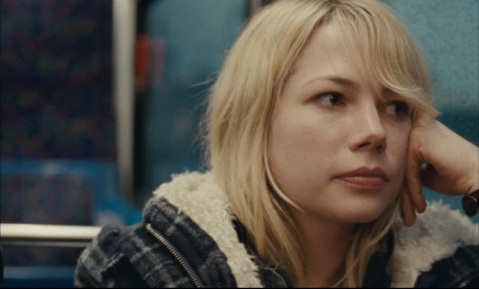
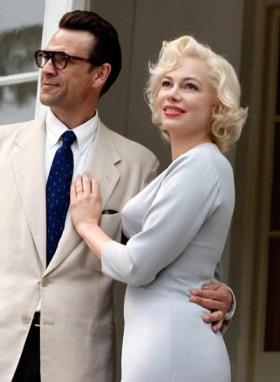
Which brings me back to the odd choice of opting to portray Monroe. Why would an actress do that to herself? Why would an actress be persuaded to step into the shoes of a woman so iconic, so famed for her beauty and full-to-bursting sensuality?
For Michelle Williams to take on the role of Marilyn Monroe is not equivalent to Meryl Streep’s roles as real-life/ historic figures. Honestly: to me it sounds like a nightmare. Who among us could survive the inevitable comparisons, the naysayers who say she’s not beautiful enough to play Monroe?
Yet after thinking so extensively about Williams’ mouth and its frequent on-screen plunges downward, its gravity and its evocation of disappointment and pain, I have now determined that this must have seemed like the most extraordinary physical challenge for an actor. She has spoken extensively about gaining weight for the role and learning how to wiggle across a room with curves (whereas Williams is normally a tiny slip of a thing, like all actresses these days).
Yeah, whatever. Actors are always gaining/ losing weight and making a big noise about it, like they want to be congratulated for how hard it is. If you ask me, the real challenge was to use her mouth differently, and thereby the rest of her face. She had to loosen up her mouth, widen her eyes, adopt a new openness and insecurity to convey a wholly different breed of fragility.
In a Vogue interview, Williams said some fascinating things about stepping into this part by thinking about Monroe’s relationship to the world:
Someone once said that Marilyn spent her whole life looking for a missing person — herself. And so she cobbled together what people thought, felt, saw, and projected onto her and made a person out of it. She had no calm center inside herself that she could come home to and rest.
The challenge was to play a person so eager to please, so eager to be visible. Marilyn’s mouth always conveyed her availability; even 50 years after her death, a photo of her will make you want to run your tongue all over her beautiful open lips. What could be a better challenge for an actor like Williams — who’s prone to such a rigid private reserve — than to try to become that woman who “had no calm center inside herself”?
It’s too bad My Week With Marilyn wasn’t a better film. But that’s really beside my larger point. Someday soon I’m going to rent it again just to watch again how Williams loosens up the bottom half of her face for the role, and think again about how it contrasts with her versions of hard, disappointed, downtrodden women like Alma and Wendy.
Is there another actor out there whose mouth does so much of the heavy lifting in her acting? And in the meantime, have you gotten around to seeing her in Take This Waltz yet?
The waltz is a vexingly difficult yet beautiful, even sexy dance.
If you imagine to yourself its thumping rhythm — that ONE two three, ONE two three pace — you can imagine the strict rules that undergird this dance, even as it permits for flourishes. You can also picture in your mind the beauty of a waltz well-danced: the sexy, closed position of the dancers, who face each other in an intimate pose of coupling, the man’s hand on her waist as he leads and she follows. You can imagine the mistakes, the possibility for breaking the mood, for stepping on a toe.

To call this film Take This Waltz — after the Leonard Cohen song, which is a loose translation of the beautiful Federico García Lorca poem Pequeño vals Vienès (“Little Viennese Waltz”), which itself replicates the pace of a waltz — is to connote the haunting, sexy unforgivingness of a dance so formal as the waltz. This conceit is both relentless and fragile, and the film is so beautifully acted and shot, that you need to see it (and you can! Rent it on iTunes or Amazon right now for $9.99; it’s also available On Demand, and it’ll come out in theatrical release in the US at the end of June 2012).
To call this an infidelity story is to reduce it to something very un-waltz-like, but at its bare bones that’s what the story treats: Margot (the always-wonderful Michelle Williams) meets Daniel (Luke Kirby) on a plane and finds herself drawn to his slim, dark knowingness. Who wouldn’t be? He glows below his tan; like a chess player, he always seems a step ahead of her in conversation, in knowing how to unnerve her, how to gaze at her with sexy purpose. At heart perhaps all of us want to have an affair — and let me assure you, we all want to have an affair with Daniel, whose good looks are not done justice by these images below. Where might he lead, if she allowed herself to dance with him?
The problem is, of course, that she and Lou (Seth Rogen) have been married for five years, and they have their own habits of movement, of dancing and quirky joking. There’s nothing wrong with their relationship: he’s a great guy, she’s fully folded into his family. And yet. When she learns that Daniel lives across the street, she can’t help but start to find loose threads in her marriage to toy with, to pull, to see faults in their fabric. She wants to abide by the rules, like her sister-in-law Geraldine who’s struggling to stay sober. But like Geraldine, she feels as if it’s only a matter of time before she fails.
To be sure, in the course of their marriage together they’ve developed some strange tics. They started as jokes, perhaps, but now they feel more like stutter-steps. Margot’s tic is an odd propensity to want to distract him while he does other things, perhaps even to rest a bit too much of their relationship on whether he can be turned away from the task of cooking or talking on the phone to kiss her. Is it still a joke after all this time? or is it a way to poke at him, to see if he’ll resist, pull away?
And then there’s Daniel. Their conversations become freighted with meaning, they grow physically closer in their flirtation with one another, yet they dance this waltz without touching, as if worried about breaking a spell, during this hot Toronto summer.
Cohen’s song is not the only one that propels this film, but its lyrics are so insistent, so sexy — they thump more than García Lorca’s, but with such driving sexual images and luscious sounds, like hot summer sex:
…Oh I want you, I want you, I want you
On a chair with a dead magazine
In the cave at the tip of the lily
In some hallway where love’s never been
On our bed where the moon has been sweating
In a cry filled with footsteps and sand
Ay, Ay, Ay, Ay
Take this waltz, take this waltz
Take its broken waist in your hand…
Writer-director Sarah Polley (Away From Her; Polley has also acted in numerous films and TV series including Go, The Sweet Hereafter, Slings & Arrows, and John Adams) has an extraordinary gift for shooting scenes with no dialogue — scenes in which the actors simply move, like dancers, through moods that rely on one another, that push back against one another. Between Daniel and Margot these scenes are some of the sexiest, most dynamic I’ve seen recently — when they ride The Scrambler together at the amusement park to the pulsing tune of The Buggles’ “Video Killed the Radio Star,” we can see in their faces that they have allowed themselves to pretend, to imagine other scenarios.
“I want to know what you’d do to me,” she later confesses — unexpectedly — over a martini. She squints up her face girlishly, as if to mitigate the effect of those words. He doesn’t let her take any of it back. It is such a sexy scene. And he’s right: that conversation makes the martinis redundant.
We all know how flirtation works, don’t we? We love to dance that dance. Flirting has its own rules, an innate nostalgia for past flirtations, its pleasures in unexpected twirls and secret improvisations. Flirting is as much about language as looks, smells, furtive touches. Cohen tells how it is:
And I’ll dance with you in Vienna
I’ll be wearing a river’s disguise
The hyacinth wild on my shoulder,
My mouth on the dew of your thighs
And I’ll bury my soul in a scrapbook,
With the photographs there, and the moss
And I’ll yield to the flood of your beauty
My cheap violin and my cross
And you’ll carry me down on your dancing
To the pools that you lift on your wrist
Oh my love, oh my love
Take this waltz, take this waltz
It’s yours now. It’s all that there is.
Does Margot feel a connection to Daniel that’s so powerful because she’s drawn to a grass-is-greener fantasy? Or could it be true love? If it’s the former — she wants something new — will that something new merely get old over time, the way things have gotten old with Lou?
The film touches lightly on those perennial questions asked by would-be adulterers everywhere, but ultimately the real question is Margot’s alone: “I’m afraid of wondering if I’ll miss it. I don’t like being in between things. I’m afraid of … being afraid.” What it is, what those things are, remain to be seen. Whether she can get over those fears also remains an open question.
This film has an unusual pace — it’s not perfect; it leaps over a couple of matters, moving the plot along. The dialogue sometimes feels … awkward? stage-y? But it’s still worth every penny of that $9.99 rental fee to see Michelle Williams play this role, to watch her flirt with Daniel in The Scrambler, to let her strange face register emotions. (I really need to dedicate a whole post to her face, especially her mouth, which I find poetic.) So what if it’s not a perfect film? It’s somehow relentless and yet delicate all at the same time, just like a Leonard Cohen song, just like a waltz, with its rules and the threat of making mistakes. ONE two three, ONE two three. Take this waltz, take this waltz.
Love and marriage are hard. Like the waltz.










